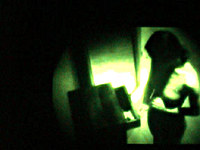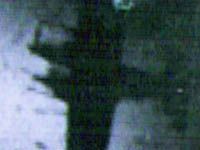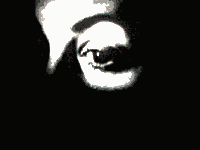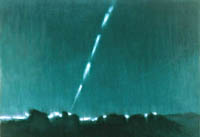

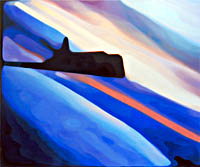 Adam Hurwitz: "Sunset," Oil on canvas, 60 x 72 in. 2000
|
Night Vision: Notes from the CuratorBy Joy GarnettLate in September 2001, some weeks after the 9/11 attacks, I attended several evening gatherings of artists in galleries and watering holes around the city. Many of us had been avoiding venturing out to social or public events, and several of us had not spoken to one another since before the attacks. Ground Zero was still smoking, most of us were back at work, but no one was really functioning normally and no one was even thinking about the true meaning of recovery just yet. War was on the horizon. We began to talk of our experiences and feelings of the past weeks, and also about our work and what we thought we should or shouldn't be doing as artists. One question that came up was whether it would be appropriate or even possible to make work that responded directly to the attacks. Then there was the question of whether it would be possible to make work that didn't respond to them in some way. With the events of 9/11 we had immediately experienced the recontextualizing of artworks already installed in galleries which found their meanings irrevocably changed, sometimes much to the chagrin of the artists: Nancy Davenport's digitally manipulated photographs of people jumping from buildings, and Wolfgang Staehle's real time video panorama of lower Manhattan are two well-known examples of this kind of diverted meaning. There was another, more plaintive question thrown out by several artists: how could we work at all at a time like this? What importance could our own stories have, dwarfed as they are by the magnitude of this catastrophe? Is making art irrelevant right now? It was this question that prodded me, since I found myself grappling with a rather different source of discomfort. My own work had long been drawn from the same image banks that were being used to illustrate the current unfolding crisis in newspapers and on television: satellite transmissions of war, declassified Department of Defense diagrams, Gulf War night vision imagery shot from the '91 evening news. Far from feeling suddenly irrelevant, I felt I was being shadowed by an awkward sense of responsibility. How had the events of September changed the significance of thesemysubjects? Did I have the emotional fiber and the creative flexibility to handle the changes? What part of these huge and complicated subjects should I be addressing? What was I doing working this field to begin with if I couldnt handle it now that Id experienced a catastrophic event first-hand? Was my problem the sudden lack of mediation?
Was I too close? The specialized niche where I had done my research and made my work was now no longer private; it had become a stage for mainstream production and consumption. Could one conduct a critical artistic analysis just as events unfolded, almost journalistically, when so little was clear and emotions were running riot? What would constitute a clear line of inquiry? What kind of art could significantly approach what so many had witnessed unmediated and en masse? And how could we expect anything we did to take on meaning or make an impact when we were already becoming fatigued by the 24/7 onslaughts of imagery and commentary? In a matter of weeks since 9/11 we had become a supersaturated public, and yet what we actually knew amounted to very little. What possible difference could an artistic treatment of these images and issues make, and how could that compete with mainstream sensationalism in this most competitive attention economy? I was not alone in these thoughts. There are many artists, both in the online community and in the traditional gallery realm, who have engaged the subjects of networks and surveillance, optics, military technology, and media images of war. I knew of artists and media theorists who called this their territory, and who had developed analytical, critical approaches to dealing with our culture's fetishistic relationship to apocalypse and destruction, communications and control, and to the ambivalently aestheticized images generated by the military and by the media. These issues had importance in theoretical, philosophical and artistic circles, long before they had become, in a shallow simplified form, ubiquitous 24-hour news items. By the end of October, and after much discussion, I finally felt clear that this was not the time to turn away from these subjects. It seemed that this was an important moment to bring a group of such artists together.
At the outset of the current war in Afghanistan, the U.S. Army coined the
motto, We own the night, referring specifically to their advanced infrared
and heat seeking equipment, and to the unparalleled technological
advantage afforded them during nighttime maneuvers. But this show's
title, Night Vision, is nothing if not ironic: to be able to see in the
dark does not necessarily mean one can make sense of what one sees. Since
the language and the job of art is to raise and reveal complexities
rather than attempt to resolve them, we may take advantage of its
unorthodox methods of inquiry and multiple readings. Art offers us a
respite and an alternative to the one-liner narratives we have become so
inured to, whether they are commercial or entertainment-driven,
newsworthy and informational, or activist/political in nature. Art offers
us rare protection against the effect of psychic numbing produced by a
bi-polar and overzealous mainstream culture.
|
